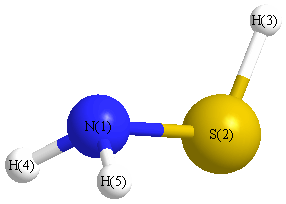Jump to
S1C2
Energy calculated at MP4/aug-cc-pVTZ
| | hartrees |
|---|
| Energy at 0K | -454.199661 |
| Energy at 298.15K | -454.203398 |
| HF Energy | -453.746362 |
| Nuclear repulsion energy | 57.409164 |
The energy at 298.15K was derived from the energy at 0K
and an integrated heat capacity that used the calculated vibrational frequencies.
Vibrational Frequencies calculated at MP4/aug-cc-pVTZ
| Mode Number |
Symmetry |
Frequency
(cm-1) |
Scaled Frequency
(cm-1) |
IR Intensities
(km mol-1) |
Raman Act
(Å4/u) |
Dep P |
Dep U |
|---|
| 1 |
A' |
3501 |
3407 |
|
|
|
|
| 2 |
A' |
2685 |
2613 |
|
|
|
|
| 3 |
A' |
1624 |
1580 |
|
|
|
|
| 4 |
A' |
1038 |
1010 |
|
|
|
|
| 5 |
A' |
890 |
866 |
|
|
|
|
| 6 |
A' |
664 |
646 |
|
|
|
|
| 7 |
A" |
3598 |
3502 |
|
|
|
|
| 8 |
A" |
1134 |
1103 |
|
|
|
|
| 9 |
A" |
407 |
396 |
|
|
|
|
Unscaled Zero Point Vibrational Energy (zpe) 7770.4 cm
-1
Scaled (by 0.9732) Zero Point Vibrational Energy (zpe) 7562.1 cm
-1
See section
III.C.1 List or set vibrational scaling factors
to change the scale factors used here.
See section
III.C.2
Calculate a vibrational scaling factor for a given set of molecules
to determine the least squares best scaling factor.
Geometric Data calculated at MP4/aug-cc-pVTZ
Point Group is Cs
Cartesians (Å)
| Atom |
x (Å) |
y (Å) |
z (Å) |
|---|
| N1 |
0.013 |
1.117 |
0.000 |
| S2 |
0.013 |
-0.621 |
0.000 |
| H3 |
-1.321 |
-0.771 |
0.000 |
| H4 |
0.507 |
1.445 |
0.822 |
| H5 |
0.507 |
1.445 |
-0.822 |
Atom - Atom Distances (Å)
| |
N1 |
S2 |
H3 |
H4 |
H5 |
| N1 | | 1.7387 | 2.3127 | 1.0137 | 1.0137 |
S2 | 1.7387 | | 1.3431 | 2.2783 | 2.2783 | H3 | 2.3127 | 1.3431 | | 2.9889 | 2.9889 | H4 | 1.0137 | 2.2783 | 2.9889 | | 1.6444 | H5 | 1.0137 | 2.2783 | 2.9889 | 1.6444 | |
 More geometry information
More geometry information
Calculated Bond Angles
| atom1 |
atom2 |
atom3 |
angle |
|
atom1 |
atom2 |
atom3 |
angle |
| N1 |
S2 |
H3 |
96.408 |
|
S2 |
N1 |
H4 |
108.869 |
| S2 |
N1 |
H5 |
108.869 |
|
H4 |
N1 |
H5 |
108.403 |
Electronic energy levels
Charges, Dipole, Quadrupole and Polarizability
Jump to
S1C1
Energy calculated at MP4/aug-cc-pVTZ
| | hartrees |
|---|
| Energy at 0K | -454.199127 |
| Energy at 298.15K | -454.202928 |
| HF Energy | -453.746634 |
| Nuclear repulsion energy | 57.594056 |
The energy at 298.15K was derived from the energy at 0K
and an integrated heat capacity that used the calculated vibrational frequencies.
Vibrational Frequencies calculated at MP4/aug-cc-pVTZ
| Mode Number |
Symmetry |
Frequency
(cm-1) |
Scaled Frequency
(cm-1) |
IR Intensities
(km mol-1) |
Raman Act
(Å4/u) |
Dep P |
Dep U |
|---|
| 1 |
A' |
3503 |
3409 |
|
|
|
|
| 2 |
A' |
2619 |
2549 |
|
|
|
|
| 3 |
A' |
1613 |
1569 |
|
|
|
|
| 4 |
A' |
1017 |
990 |
|
|
|
|
| 5 |
A' |
883 |
859 |
|
|
|
|
| 6 |
A' |
644 |
626 |
|
|
|
|
| 7 |
A" |
3609 |
3513 |
|
|
|
|
| 8 |
A" |
1118 |
1088 |
|
|
|
|
| 9 |
A" |
503 |
489 |
|
|
|
|
Unscaled Zero Point Vibrational Energy (zpe) 7753.7 cm
-1
Scaled (by 0.9732) Zero Point Vibrational Energy (zpe) 7545.9 cm
-1
See section
III.C.1 List or set vibrational scaling factors
to change the scale factors used here.
See section
III.C.2
Calculate a vibrational scaling factor for a given set of molecules
to determine the least squares best scaling factor.
Geometric Data calculated at MP4/aug-cc-pVTZ
Point Group is Cs
Electronic energy levels
Charges, Dipole, Quadrupole and Polarizability
